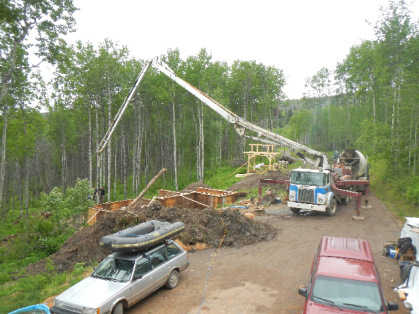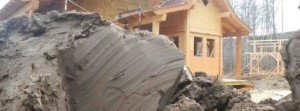
Houses, armies and racehorses
When building a straw bale home, there’s one key ingredient: straw. That’s why, as the weeks ticked along, by mid-May I began to worry that we hadn’t lined up — hadn’t even begun to look into — the bales for our straw walls.
And, of course, when I contacted Smithers-based trucker Wes Schultz a couple weeks ago, he told me what I’d been fearing: the earliest we were likely to get straw was October, when this year’s crop was available. Last year’s bales were completely sold out.
To keep things positive, here are the benefits of getting your straw in October: unless things go terribly sideways, we should have a frame in place and roof over our heads well in advance of October, giving us a large, dry area to store our bales over the winter. Come next spring, we have all summer long to wait for the right weather to put our walls in place and plaster them.
The problem is, I don’t want to wait till next summer. I don’t want to spend all winter twiddling my thumbs until the weather improves. I want my walls, doors and windows in place this year, leaving us all winter to finish the interior so I can live in my house next summer. So, when I spoke with Wes, my heart kinda sank.
Wes is a bit of a straw expert. He does long-haul trucking between Smithers and Saskatchewan and knows all the good straw producers in between. When he heard my disappointment over the phone, he promised to put some feelers out on his next trip east. And, much to my excitement, Wes came through.
He called last week to say that his best producer was holding 500 bales for a buyer who didn’t need them till October. Thus, we could have the bales and the other client would take the next batch — this year’s crop, as opposed to last year’s. Hearing that the producer is his best also lifted my spirits.
“Houses are his specialty,” Wes explained over the phone from Saskatchewan. “He bales straw specifically for building houses: houses, racehorses and the army.”
The army, he explained, builds straw houses for the sole purpose of blowing them up.
“Awful waste of straw, if you ask me,” he added.
Wes went on to explain that straw bale houses are becoming common enough for producers to bale specifically for the building market. Building bales need to be tight, dry and uniform. The 42-inch-long bales that Wes was offering were just what we wanted — way better than those flimsy 36-inch bales, he assured me.
Wes knows how to talk. He also knows his straw, which is very reassuring for a couple of rookie straw homebuilders two provinces away. Barley, wheat, rye — there are varying opinions on what type of straw is best for building, but we were beyond caring. If they were tight and dry, we’d take them.
This week, Wes is planning what might possibly be his last trip back to the valley until later in the year. Depending on the status of a tractor that needs to get to Prince George, he will — hopefully — be carrying our load of almost 70 cubic metres of straw. We, on the other hand, will be here in soggy Smithers trying to find a nice, dry place to store it all.
That’s OK. Just as long as we can get to it before the army does.
Postscript: I’m posting this to the sound of a pump truck pouring our basement walls. In the end, we went with a regular basement. As it turns out, the slope of our land means we’ll have more basement walls framed than concrete, so ordering an expensive product just to bury it underground didn’t seem worthwhile. Plus, I’ll be happy to have that few thousand dollars we saved when it comes to finishing! In the meantime, not sure how a person’s supposed to get any work done around here…
http://strawbaletales.wordpress.com/



